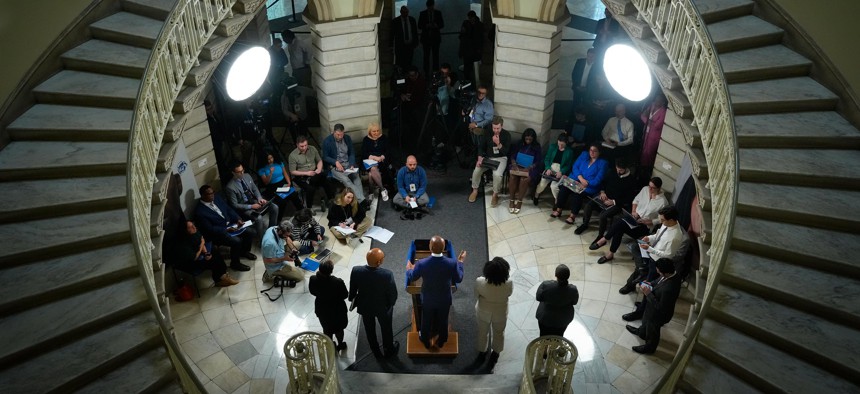Policy
Eric Adams’ executive budget, by the numbers
A look at New York’s city’s fiscal year 2024 budget proposal.

Mayor Eric Adams proposed a $107 billion budget. Michael Appleton/Mayoral Photography Office
New York City Mayor Eric Adams unveiled a $106.7 billion budget proposal for fiscal year 2024 on Wednesday – the largest in city history – backing off, in small part, from some of the 4% agency cuts he’s stressed as necessary. The proposal reflects few, if any, direct service cuts, while adjusting spending estimates downward to hedge for future “storm clouds ahead” like ongoing costs associated with the influx of asylum-seekers, according to Adams. The proposal also includes a limited slate of new spending proposals to, as Adams put it, improve the city’s sustainability and resilience, strengthen mental health resources, uplift “working people,” and bolster the college to workforce pipeline.
“We had to make tough choices in this budget. We had to negotiate competing needs. We realize that not everyone will be happy, but that is OK,” Adams said from City Hall Wednesday afternoon.
Here are some of the top numbers you need to know to understand the city’s finances.
$106.7 billion – The size of the proposed expense budget, which is the largest ever. The total spending increased $4 billion dollars since the preliminary budget, which landed at $102.7 billion in January. The actual adopted budget last June was $101 billion… but the city is now expecting to actually spend $108.9 billion through the end of fiscal year 2023.
$4.2 billion, $6 billion, $7 billion – The respective budget gaps in fiscal years 2025, 2026 and 2027. While Adams presented a balanced budget for the current fiscal year and the upcoming fiscal year 2024, hefty budget gaps remain in the outyear due in part to increased pay for city workers under new labor contracts. Fiscal watchdogs have warned that these budget gaps necessitate caution in New York City’s current spending plans.
$1.6 billion – The total savings achieved between fiscal years 2023 and 2024 through the latest Program to Eliminate the Gap, according to City Hall. Adams said that these cuts were accomplished without any layoffs or service reductions – but with some savings achieved by taking vacant jobs off the rolls, it’s unclear how the city will maintain previous levels of service.
$4.3 billion – The amount of money that the city anticipates spending on providing shelter, food, clothing and other services to asylum-seekers through the end of fiscal year 2024. This is a figure that Adams has pointed to repeatedly in recent weeks as one of the big reasons that cuts are necessary. While the city will likely receive $1 billion in aid from the state, and predicts getting $600 million from the federal government, that total would only cover under 40% of the city’s projected costs.
Over 57,000 people – The latest estimate of how many asylum-seekers have arrived in New York City in the past year. Some 35,000 are currently in city shelters, City Hall says.
70,000 people – How many asylum-seekers City Hall anticipates will be in the city’s care by June 2024.
$16 billion – The total anticipated cost of agreements with the city’s remaining unionized workforces that have yet to strike deals, over the next five years. The city has already reached agreements with District Council 37 and the Police Benevolent Association, which will likely set the economic framework for ongoing negotiations with the United Federation of Teachers and other labor groups.
26 days – How late the state budget is past the April 1 deadline – and counting. Adams is releasing its executive budget without final numbers from the state, which funds about 17% of the city budget. “We may have to go back,” to create new estimates after it’s finalized, Adams said, “and our budget mod is going to reflect that.”
50% – Of working-age households in New York City don’t make incomes that cover their basic needs like housing, food, transportation and health care, according to a report sponsored by the United Way of New York City and the Fund for the City of New York. While the jarring figure is not included in Adams’ budget proposal, its recent release adds gravity to the negotiations over proposed cuts to programs and services.
$23.2 million – The cost of expanding the Department of Sanitation’s voluntary curbside composting program to all five boroughs by 2024. While Adams mostly focused on savings, this was one of a few new, relatively low-cost initiatives added to the budget.
$27 million – Baseline funding allocated to continue the expansion of the Behavioral Health Emergency Assistance Response Division, or B-HEARD pilot program into the rest of the Bronx as well as other high-need neighborhoods throughout the city. The program, aimed at changing how the city responds to mental health emergencies by dispatching social workers and paramedics to people in crisis, is currently operating in a handful of neighborhoods.
“Not a single penny” – How much library budgets would be impacted by the latest round of PEG cuts after the city determined that the systems’ services would be severely impacted by the cut. But library systems’ funding would still be reduced from the current fiscal year, based on the previous PEGs.

NEXT STORY: Adams backs off full 4% cuts for some agencies in executive budget proposal
